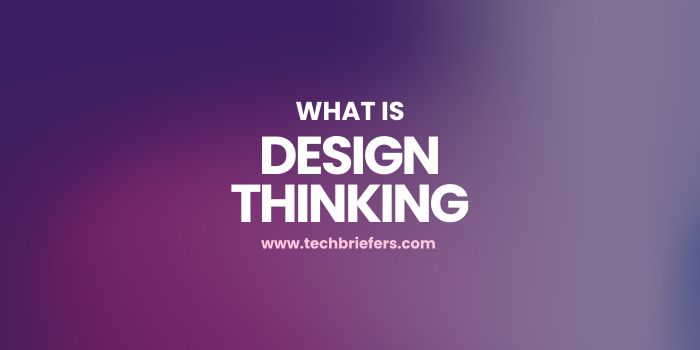What is Design Thinking? Definition and Stages

Have you ever heard of the concept of Design Thinking? You might think this is a designer’s job. However, many fields ranging from business, technology, architecture, and even some leading companies apply this concept. So what exactly is Design Thinking? Before you use this concept, you need to know what Design Thinking is. What are the principles, steps, and examples of its application? Read the full article below.
What is Design Thinking?
Design Thinking is an iterative process where you try to understand users, challenge assumptions, and redefine problems to identify alternative strategies and solutions that are not immediately obvious to the eye with an initial level of understanding.
In general, Design Thinking is an innovative approach that focuses on human needs to create effective and sustainable solutions. Unlike traditional methods that focus on products, Design Thinking focuses on user experience. This will create relevant solutions and per user needs.
Therefore, this method is widely applied in various fields, such as business, education, health, and product design because this concept has been proven to be effective in solving complex problems and producing useful innovations.
Also read: 40 Mind-Blowing Computer Facts about the First Computer
Why is Design Thinking Important?
Design Thinking encourages creativity and innovation. As humans, we rely on the knowledge and experiences we have accumulated to take action and solve problems. We form patterns and habits that, while useful in certain situations, can limit our view of things when it comes to problem-solving. This method encourages us to let go of our understandings and assumptions, and then consider alternative solutions.
So it is often referred to as a healthy middle ground in problem solving. Another great benefit of Design Thinking is that it puts people first. With a strong focus on empathy, Design Thinking encourages businesses and organizations to consider the real people who use their products and services.
This will help businesses achieve their goals in terms of creating meaningful user experiences. For users, this means they will get better and more useful products that solve their problems. For businesses, this means happier and more loyal customers and bringing profits to the company.
Design Thinking Steps
There are several stages in Design Thinking which are divided into five phases, namely empathize, define, ideate, prototype, and test. A complete explanation of the design thinking steps is as follows:
Empathize
Empathizing is the first stage to gain an empathetic understanding of the problem being solved. This stage is an attempt to feel and understand what the customer is thinking. In empathize, it is divided into several stages, namely observe, engage, and immerse.
The observe stage is observing consumer behavior and actions. The observation results are followed up with the engage stage . The engage stage is building direct interaction with consumers through interviews , FGD (Focus Group Discussion) , and so on. The last stage of empathize is immerse or participate in carrying out various activities carried out by consumers.
Define
The stage for finding problems to produce useful solutions for consumers is the define stage . The way to find problems is by observing and finding important problem patterns from the previous empathize result map.
At this stage, it helps you to gather great ideas to build features, functions, and elements that allow you to solve the problem. Once the problem is found, you will find a problem worth solving . The benefit of define is that you are more focused on making a clear problem pattern so that ideas can be easily found.
Ideate
The third step in Design Thinking is to collect ideas, then determine and find solutions to existing problems. Brainstorming will produce innovative ideas that are desired to solve problems. To find solutions, you can use several tools , such as mind mapping (thinking framework) and brainstorming. The ideas obtained are free or as wild as possible, there are no limits in finding ideas. The ideas collected are then categorized from realistic to unreasonable. Then combine with several ideas in different categories. This combination will produce alternative ideas.
Prototype
Prototypes are needed so that ideas can be seen and felt by the five senses. The goal is to make ideas easier to learn and evaluate. Examples of prototypes that are made are sketches, drawings, miniatures, and mockups. Prototypes can be tested by the team itself or a group of people outside the team. This is an experimental phase that aims to identify the best solution to each problem. The final stage, you will have a better idea, a clear view of how users actually behave, think, and interact.
Test
The last step in Design Thinking is testing or testing the prototype to consumers. Ask your consumers to try exploring the prototype then ask for feedback that is used as an evaluation. The evaluation results are the basis for improving or redesigning the prototype until the results are considered good enough. There are three main principles in conducting testing, namely: Show don’t tell , meaning let consumers explore and don’t provide an explanation, create experience , meaning testing must provide an experience to consumers, ask users to compare , meaning ask consumers to compare the prototypes made.
Also read: Half Border Design And Fixed Width Border Design In CSS
Examples of Design Thinking Applications
For example, the application of design thinking in a Gojek company. Starting from observing that there are problems in society in getting safe and affordable transportation. Nadiem said that the motorcycle taxi sector is very valuable. Starting from his personal experience, he chose to take a motorcycle taxi rather than driving a car. Another fact, Nadiem found the income of a motorcycle taxi that worked for 14 hours, but only got 4 passengers.
Then, a potential problem statement was found , namely that people need alternative transportation to avoid Jakarta’s traffic jams and motorcycle taxis need certainty of income (passengers). Based on this concern, it will become the basis for creating its product, namely a connecting tool between the needs of passengers and motorcycle taxi drivers. Finally, in 2010, Nadiem created a call center via telephone. If there is a customer who needs a motorcycle taxi, contact the call center . The final stage in 2015, the release of the Go-Ride application which continues to be developed until now.
Also read: 5 secret Google Drive features you rarely know
Closing
Thus the explanation of Design Thinking starts from how its principles, Design Thinking steps, and examples of its application. This concept is suitable for you to apply to various fields because it is useful for business and product development.







Leave a Reply